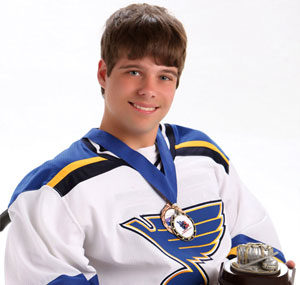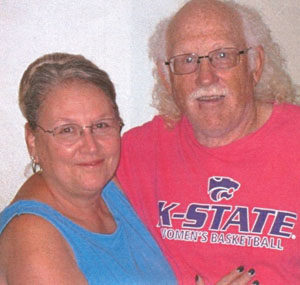
Mar 11, 2013 | Recipient Stories
 Charlene, a cornea transplant recipient from De Soto, KS, calls her experience with transplantation a “journey.” With her sight diminishing, she worried about her position as a third grade teacher in a parochial grade school. “Teaching is what I have done,” she said, “and it’s a lot of my identity.” Without the ability to see, however, she lost her capacity to teach, her self-reliance, and her ability to focus on the important things in life. “My whole life became about taking eye drops and treating the disease,” she said.
Charlene, a cornea transplant recipient from De Soto, KS, calls her experience with transplantation a “journey.” With her sight diminishing, she worried about her position as a third grade teacher in a parochial grade school. “Teaching is what I have done,” she said, “and it’s a lot of my identity.” Without the ability to see, however, she lost her capacity to teach, her self-reliance, and her ability to focus on the important things in life. “My whole life became about taking eye drops and treating the disease,” she said.
In January 2012, Charlene began to experience irritation in her left eye. Soon she was seeing her optometrist every two weeks to treat the infection that had developed. The cause of the infection was a combination of irritation to her eye from contact lens use and the Acanthamoeba, a microscopic single-celled organism common in water and soil. “Rinsing my contact with my tap water and then putting the contact in trapped the amoeba,” she said. According to the Centers for Disease Control and Prevention, most people are exposed to the amoeba in their lifetime, but unfortunately, Charlene is one of the few people who have contracted Acanthamoeba keratitis from exposure. In mid-March the optometrist referred her to an ophthalmologist for advanced treatment, but the infection continued to worsen. Charlene recalls her last good day of sight because it was Good Friday. Over Easter weekend, her eyesight diminished while the pain increased. On Tuesday she was referred to a cornea specialist, and finally she was referred to Dr. Bishara of University of Kansas Hospital for a cornea transplant consultation. Dr. Bishara informed Charlene that she was to embark on a journey, and after exhausting all other possible treatments, they scheduled her for corneal transplant surgery on June 15.
The months leading up to the surgery were difficult. “The pain was so excruciating,” Charlene recalled. “I had to draw the drapes in my home, and even the television provided too much light. I wore sunglasses everywhere.” Her friends, sons, and daughters-in-law had to take her to her medical appointments, so thankfully she had such a strong support system. Even the 60 children she taught and her fellow teachers came to visit her. But in the end, her surgeon was correct: it was Charlene’s journey, her path through the darkness. “These people could have sympathy for me,” she said, “but they couldn’t know what I was experiencing.” Without her vision, she would lose her ability to teach, which had become integral to both her life and her livelihood. It was in this time, uncertain of the future of her sight, she began to ask herself questions such as, “If I can’t see, who am I?”
On the day of the operation, Dr. Bishara explained the corneal transplant procedure to Charlene and then talked her family through the logistics. “Dr. Bishara is personable and brilliant,” Charlene said of her surgeon. “She’s one of the best friends I’ll have in my lifetime.” The reason for Charlene’s exuberance about her surgeon is clear: Charlene’s eyesight returned very slowly for a couple weeks, but by the middle of July, she had recovered enough that she was able to return to her school to prepare her classroom for the upcoming school year.
About her journey these days, Charlene says, “Don’t let me waste my days. I feel like I’ve been truly given a gift.” Charlene had never encountered donation before her transplant, but now she wants to be a donor, she’s written to her donor family, and she teaches others about her experience with donation. She told one of her sons about her wish to be a donor, and he joked that his mother was too old to donate, but Charlene knows that isn’t the case. “It is such a simple thing to say that I want to give something back to someone else,” she said. In fact, anyone who wants to donate can sign up for the donor registry, regardless of health, age, or any other characteristic.
What’s more, most people can become eye donors. Age, race, gender, and blood type don’t affect a person’s ability to give the gift of sight. Neither will a diagnosis of cancer, diabetes, or poor vision. In short, people who sign up for the donor registry are simply stating that they would like to be a donor if it is medically possible at the time of passing. But perhaps Charlene explains this best: “No matter our age or our health, there are often things we can leave behind that other people will be able to utilize. The gift of our life is something we can share with others.”
Join Charlene in pledging to be an eye, organ and tissue donor on the Donor Registry so people like Charlene will be able to receive the gift of sight when they so desperately need it. To learn more about eye donation, please visit the About Cornea Donation section of our website.

Feb 6, 2013 | Donor Stories

Danial played for the St. Louis Blues sled hockey team that won a national championship in April 2012.
A Young Man’s Legacy: Coices of Independence and Donation
I. “Everybody loved Danial, and he loved everyone.”
When Danial Miller was born with spina bifida, the most common permanently disabling birth defect in the United States, his mother, Terri, decided she would do whatever it took to give him a “normal and independent life.” And by all accounts, he had just that. Danial used a wheelchair, but he also learned to drive, went to prom, played piano (“Lean On Me” was his favorite song), wrestled for the Hillsboro High School team, and started college coursework.
In the small, rural town of Hillsboro, Illinois, Danial was well-known, and the community embraced him. Hillsboro may not be the most accessible place on Earth for someone with a disability, but this did not prevent Danial from making an impact there. “He felt empathy for others,” Terri said. “He would talk his friends through the problems they were facing.” It is most certainly Danial’s abilities to give of himself to others and excel in his many interests that make his life so memorable.
II. “This is what I want to do.”
What wasn’t simply “normal” about Danial’s life was his interest in and success at sled hockey. Sled hockey is an adaptation of ice hockey that involves equipment altered to enable people with physical disabilities to skate and play.
While at a St. Louis Cardinals game, the Miller family was approached by a representative of the Disabled Athlete Sports Association (DASA), who asked if Danial liked sports. He responded, “I love sports, but I can’t play much.” And with that, the Millers’ relationship with DASA was formed. What would begin with a DASA-sponsored kayak outing eventually led to Danial joining the St. Louis Blues Sled Hockey team.
The first time Danial got off the ice rink, he knew sled hockey was for him. “It changed his life,” Terri said. “On the ice he could do the things he wanted to do. His disability was gone on the ice.” Excelling at hockey improved his self-esteem and self-confidence. In fact, Danial’s team went on to win the national championship in Dallas, Texas in April 2012 by defeating the Blackhawks 4-3 in overtime.
III. “I’ve lived with a disability. If someone could give me a gift to heal me, you bet I’d take it, and I’d be so grateful for it.”
Part of the independent life Danial led involved learning to drive. The Millers hired an instructor from the St. Louis area to teach him to drive on a vehicle modified so as to be driven entirely with his hands. When he got his license, Danial made the choice to sign up for Illinois’ state donor registry. “He was clear on what he wanted to do,” Terri said.
When Danial died last June of complications related to his condition, just two weeks after his eighteenth birthday, there was no question in Terri’s mind that he would become an eye, organ, and tissue donor. He was able to save and improve the lives of numerous people by donating his corneas, kidneys, pancreas, liver, and heart valves as well as other tissues for spina bifida research.
Danial’s cousin had received a cornea transplant a year before he passed away, so he understood firsthand just how much eye donation can help another person. The Miller family had summer plans to go to the Gulf of Mexico so Danial could finally experience the ocean, and, as it turns out, his corneas were placed in Hawaii. In a way, Terri said, “he got to see the ocean.”
IV. The Danial Miller Memorial Fund
His legacy of giving lives on in the Danial Miller Memorial Fund. Begun by Terri soon after Danial’s passing, the fund is committed to helping eliminate barriers to independent living for people with disabilities, and it supports programs that allow them to live more fulfilling lives through greater opportunities. Terri uses the fund as a clearinghouse to donate to other causes. Some organizations the fund has already supported include St. Jude Children’s Research Hospital and Hillsboro Runners Club. And in the future, Terri would like to give to DASA Sports, the Spina Bifida Association, and Shriners Hospitals for Children and to fund projects in her community that support activities and accessibility for disabled people. To learn more and to support the fund, you can visit www.danialmiller.com.
Danial’s legacy also illustrates the lasting benefits of eye, organ, and tissue donation. “I buy into the idea of donation,” Terri said. “Nobody gave up on Danial even though he was a donor.” His decision to be a donor has significant longterm effects in the lives of his recipients, including the gift of sight, the gift of life, and the potential for advancements in spina bifida treatment. They’ll regain the independence Danial and his family were always choosing to pursue. As Terri put it, “Danial’s whole life was about choosing life,” and as a donor, he’s done just that.
Read more about eye donation on our site, and sign up to be an eye, organ, and tissue donor on your state’s donor registry at Donate Life America.

Sep 21, 2012 | Recipient Stories
 For years, Judy of Manhattan, Kan. struggled with vision loss due to Fuchs’ dystrophy, a degenerative disease of the cornea. As the condition progressed, she had difficulties reading a phone book or seeing the license plate on the car in front of her.
For years, Judy of Manhattan, Kan. struggled with vision loss due to Fuchs’ dystrophy, a degenerative disease of the cornea. As the condition progressed, she had difficulties reading a phone book or seeing the license plate on the car in front of her.
By the time her eyesight declined to 20/70, her surgeon encouraged her to proceed with a cornea transplant using donated tissue to save her vision, but she was still hesitant.However, after talking with a family friend whose son had been an organ donor, she began to reconsider.
“In visiting with his mother several times, she talked about how good it made her feel to know others had been helped even in the time of their loss.”
Judy decided to accept the gifts of two generous donor families who made the heartfelt decision to let their loved ones live on through others. In June 2011, she underwent a cornea transplant on her left eye and then again in March 2012 on her right eye. Today, Judy is seeing 20/25 with or without glasses.
“In a sense I didn’t realize how bad my sight had been until after my transplants. Some days my sight is so good, it’s unbelievable. I still have a bit of astigmatism, but I can see my grandson playing ball. I can follow college basketball and helicopters flew over my home the other day, and for the first time, I could really see them in detail.”
Judy’s transplants have allowed her to continue working part-time as a clerical assistant at a church and enjoying her favorite hobbies, most significantly her role as director of Toys for Manhattan. Each year, this community-wide volunteer program collects toys to distribute to emergency shelters, crisis centers, and individual families so that everyone can have a happy holiday season. In fact, under Judy’s direction, more than 500 families were helped this past year.
Because of her donor families’ generous decisions, Judy is able to continue paying it forward in her community. “They’ve very precious people. I know it had to have been hard for them, but to make that commitment to carry on is miraculous.”
For more details on how you can help give the gift of sight in Kansas, visit www.donatelifekansas.com.

Jun 11, 2012 | Recipient Stories

Since receiving her cornea transplant, Elaine was able to return to the activities she loves, free from pain caused by Fuchs’ dystrophy.
Losing your eyesight is incredibly devastating on its own. But to suffer from unbearable pain while your vision quickly vanishes is something many of us can’t imagine.
Since she was a child, Elaine of East Alton, Ill. had problems with her eyesight. She underwent two surgeries in childhood to correct her strabismus, a muscle disorder that caused her right eye to misalign, and as she grew older, began suffering from glaucoma and dry eye. Yet nothing could have prepared her for her battle with Fuchs’ dystrophy, a genetic disease which would quickly destroy her cornea.
In July 2011, after Elaine began noticing her eyes were watering uncontrollably, her doctor upped her dry eye medication. However, the condition became excruciating – Elaine’s eye was red and swollen, causing her incredible discomfort and affecting her ability to work. Three weeks later, she was diagnosed with Fuchs’ dystrophy, and four months later, learned that ¾ of her right cornea was destroyed. An immediate cornea transplant would be the only way to save her vision.
Unfortunately, another eye problem would step in the way of her recovery – Elaine underwent a cataracts surgery in January 2012. The 30 days between her cataracts surgery and her transplant were filled with fear as the medicine did little to relieve her agony. “When medicine controlled the pain, that was one thing. I thought, ‘I can do this.’ But when it stopped working, the pain was indescribable. The watering made my dry eye worse, which was a constant cycle. In the end, it was unbearable.”
The Fuchs’ eventually impacted all areas of her life – the eye disease held her back from doing the things she loved. “Without a transplant, I knew I couldn’t keep working. I basically kept myself in the house, and I gained weight because I was so miserable. I’m used to going out, seeing my friends, having people over for dinner – but the condition got to be too painful. There was nothing the doctors could do.”
Finally, seven months after her diagnosis, Elaine underwent a much-anticipated transplant on her right eye, using tissue donated by a generous donor family.
Soon after surgery, her pain disappeared and her sight began to reappear. Someone who could see figures with her right eye, but not well enough to read – even with glasses – could now read the third line on an eye chart with her glasses.
Elaine no longer has to fear having to quit her job as an inpatient coder for a large St. Louis hospital because of going blind in both eyes at the same time. Now, when her left eye progresses to the end stage of the disease, she will have her right eye to see with. Because her transplant eliminated her intense pain, Elaine is also back to the hobbies she loves, including playing board games, listening to music, dancing, exercising, and playing with her cats.
For Elaine, her donor family has improved her life dramatically and reaffirmed her lifelong decision to become an organ donor herself. “It’s so hard to describe in words, but my donor family has given me my life back. I can work, I can enjoy life, I can go out again. I can have my right eye open and not be in severe pain. Before the surgery, I would have taken blindness over the pain. Now I’ve got everything – I’ve got an eye I can see out of, and I don’t have the pain. I can’t thank them enough.”

May 11, 2012 | Recipient Stories

After Robin received her cornea transplant, her eyesight improved from 20/200 to 20/70 in one day.
For five years, Robin of St. Louis adapted her life around her declining vision. Yet, because of two generous donor families and a talented eye surgeon, her lost vision was restored soon after her cornea transplants.
In 2007, Robin, a busy working mom and business analyst for a local corporation, began noticing her vision appeared cloudy. Although her doctor diagnosed her with Fuchs’ dystrophy, they both thought it would be years before drastic measures would need to be taken to save her vision.
However, two years later, after losing much of the vision in her right eye, Robin could no longer read out of her left eye as well. Once she underwent a necessary cataracts surgery, her eyesight declined to 20/200, leading her ophthalmologist to believe if she didn’t undergo a cornea transplant within the year, she would lose her vision completely.
Said Robin, “After my cataracts surgery, I couldn’t watch TV or garden. I had to get a bigger computer monitor at work and change the font size on all of my computer access programs. I had still been able to drive because of my left eye, but once I lost vision in both, I knew I couldn’t drive any longer.”
Robin underwent two transplants in 2010 – one in June and one in December. According to her, the outpatient surgery was “amazing.” Within one day, her eyesight improved from 20/200 to 20/70, within four days she could watch T.V. again, and within seven, she was back to driving. Overall, it took about three months for her vision to completely stabilize.
Robin noted that her vision is better today than it was when she was 11. She no longer has to wear glasses to work on the computer, and she has been able to return to her favorite hobbies, including traveling and knitting. Most important, she is finally able to see with clear vision her son compete in high school sporting events.
“I’m just so incredibly grateful to my donor families. I can appreciate how difficult that decision was for them, but I’m so thankful they did what they did. I’ve been a registered organ donor for 30 years, but I really never thought I would end up being a recipient. Donation is such an incredible gift that people can give – it definitely impacts another person’s life.”

 Charlene, a cornea transplant recipient from De Soto, KS, calls her experience with transplantation a “journey.” With her sight diminishing, she worried about her position as a third grade teacher in a parochial grade school. “Teaching is what I have done,” she said, “and it’s a lot of my identity.” Without the ability to see, however, she lost her capacity to teach, her self-reliance, and her ability to focus on the important things in life. “My whole life became about taking eye drops and treating the disease,” she said.
Charlene, a cornea transplant recipient from De Soto, KS, calls her experience with transplantation a “journey.” With her sight diminishing, she worried about her position as a third grade teacher in a parochial grade school. “Teaching is what I have done,” she said, “and it’s a lot of my identity.” Without the ability to see, however, she lost her capacity to teach, her self-reliance, and her ability to focus on the important things in life. “My whole life became about taking eye drops and treating the disease,” she said.




